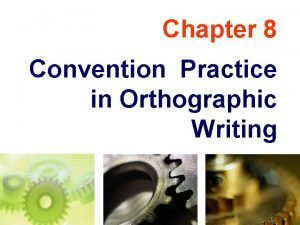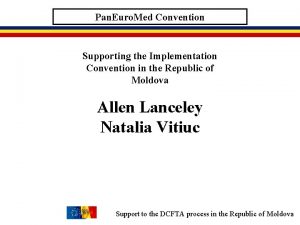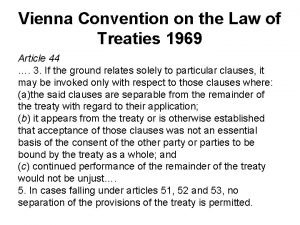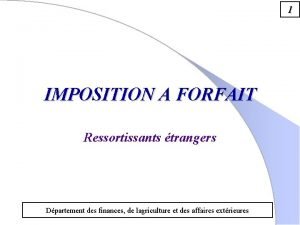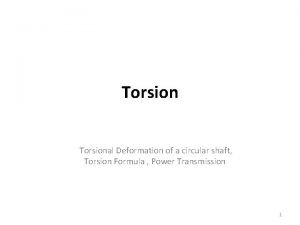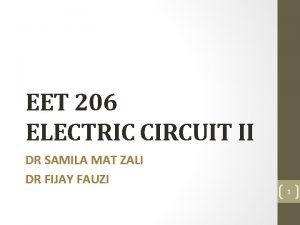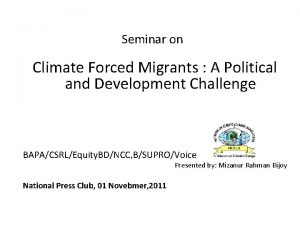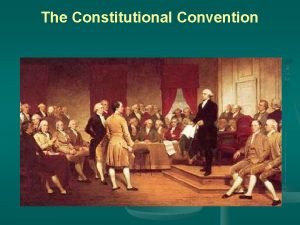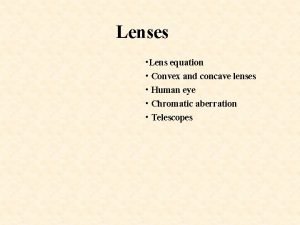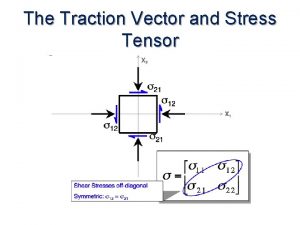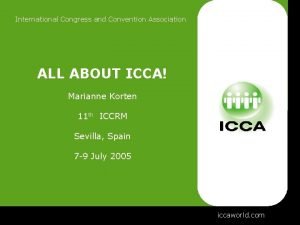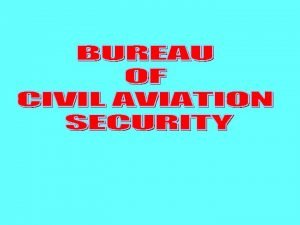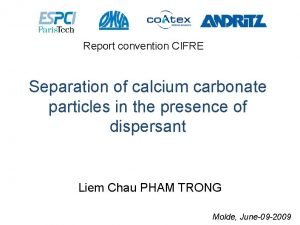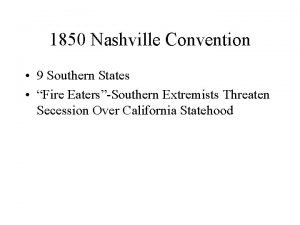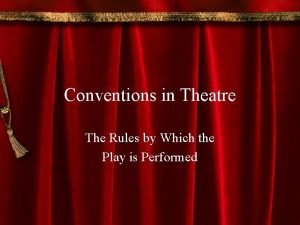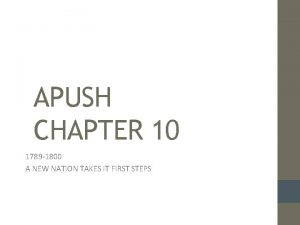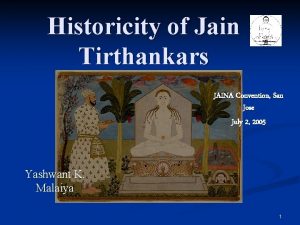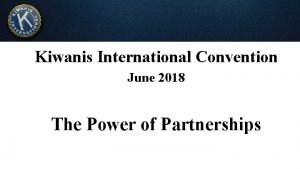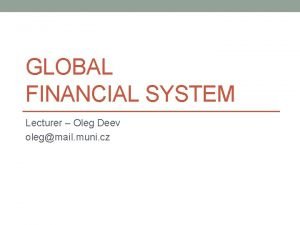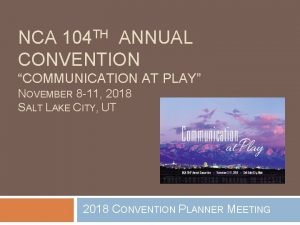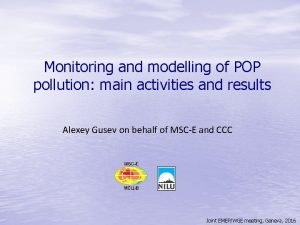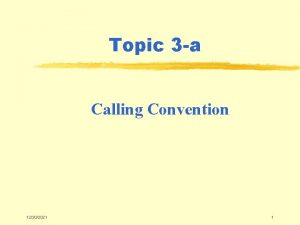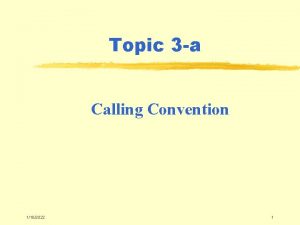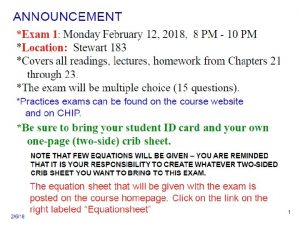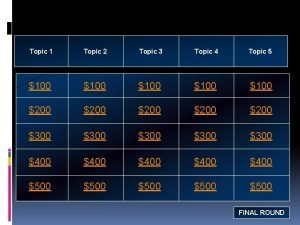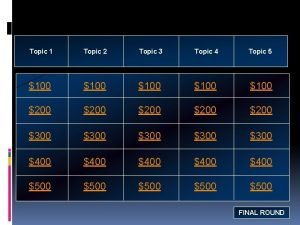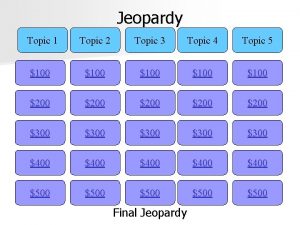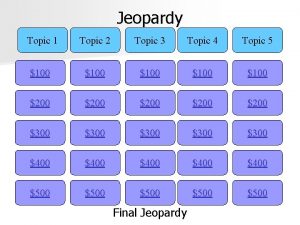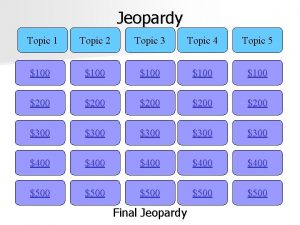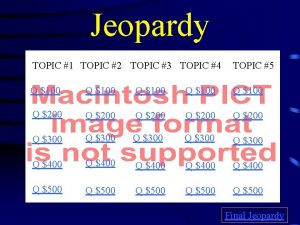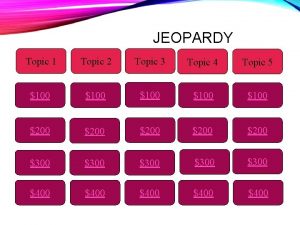Topic 3 a Calling Convention 12182021 1 Calling

































- Slides: 33

Topic 3 -a Calling Convention 12/18/2021 1

Calling Convention Calling convention is a standardized method for a program to pass parameters to a procedure and receive result values back from it. 12/18/2021 coursecpeg 421 -08 sTopic-3 -a. ppt 2

Consideration of Call Convention • Where to place parameters and return values (in registers, on the activation stack, or a mix of both) • The order in which parameters are passed • Responsibility for setting up and cleaning up a function call - distributed between the calling and the called code. • Different platforms use different call conventions, and so can different programming languages, even on the same platform. 12/18/2021 coursecpeg 421 -08 sTopic-3 -a. ppt 3

Issues in Calling Convention • Register usage convention • Calling sequence • Parameter passing • Local data layout 12/18/2021 coursecpeg 421 -08 sTopic-3 -a. ppt 4

Register Usage Convention • Special registers -- stack register, frame register, return address register, return value registers) • Reserved registers • Temporary registers (not preserved across a procedure call) • Saved Registers (preserved across a procedure call) 12/18/2021 coursecpeg 421 -08 sTopic-3 -a. ppt 5

Context Switching –Register Saving Register contents are saved before context switching into another procedure. • Caller-save versus Callee-save disciplines • Contents saved in frame of saver • Often choose to keep values in registers for efficiency 12/18/2021 coursecpeg 421 -08 sTopic-3 -a. ppt 6

Register Saving (Con’t) • Caller save The calling procedure (caller) is responsible for saving and restoring any registers that must be preserved across the call. The called procedure (callee) can then modify any register without constraint. • Callee save The callee is responsible for saving and restoring any registers that it might use. The caller uses registers without worrying about restoring them after a call. 12/18/2021 coursecpeg 421 -08 sTopic-3 -a. ppt 7

Without Register Saving Assume register set: saved registers + temporary registers main (){ …; sub. A; } can use saved registers, temporary registers sub. A(){ …; sub. B; …; } can’t use saved registers but can use temporary registers sub. B(){} can’t use saved registers but can use temporary registers can’t save any value in saved registers! 12/18/2021 coursecpeg 421 -08 sTopic-3 -a. ppt 8

Caller Save/Callee Save Trade-Off • If all caller save ? § Even callee doesn’t kill any of the saved registers – waste of cycles and memory resource • If all callee save ? § Callee has to save all the register (which will be used by callee), even caller doesn’t use them 12/18/2021 coursecpeg 421 -08 sTopic-3 -a. ppt 9

Caller Save/Callee Save Trade-Off • caller save temporary registers • callee saved registers 12/18/2021 coursecpeg 421 -08 sTopic-3 -a. ppt 10

Caller save example Function B Function A Add $10, $11, $12 Save $10, $12, $13 Add $2, $4, $5 Jal B Br $31 Restore $10, $12, $13 Sub $11, $2, $12 Mul $12, $10, $13 How to save ? 12/18/2021 coursecpeg 421 -08 sTopic-3 -a. ppt 11

Callee Save example Function A Function B Add $10, $11, $12 Save $10, $11, $12 Jal B (if they are used in B) Add $11, $2, $12 Lw $10, 4(sp) Mul $12, $10, $13 Sub $11, $8, $9 Sub $12, $11, $10 Sub $2, $11 Restore $10, $11, $12 Br $31 12/18/2021 coursecpeg 421 -08 sTopic-3 -a. ppt 12

Callee Save example Function A Function B Add $10, $11, $12 Jal B Add $2, $4, $5 Sub $11, $2, $12 Br $31 Mul $12, $10, $13 No save! 12/18/2021 coursecpeg 421 -08 sTopic-3 -a. ppt 13

Calling Sequences A calling sequence is code statements to create activation records on the stack and enter data in them. It consists of call sequence and return sequence. 12/18/2021 coursecpeg 421 -08 sTopic-3 -a. ppt 14

Calling Sequences (Con’t) • A call sequence allocates an activation record and enters information into its fields. -- parameters, return address, old stack top, saving registers, local data, etc. • A return sequence restores the state of the machine -- return value, restore registers, restore old stack top, branch to return address • The code in calling sequence is often divided between the caller and the callee. 12/18/2021 coursecpeg 421 -08 sTopic-3 -a. ppt 15

Calling Sequence Implementation: Approach I More responsibilities are in caller side. Call sequence: • Caller evaluates actual parameters • Caller stores a return address and the old stack top into callee’s AR. • Caller pushes the AR (i. e. increment top_sp) • Callee saves register values and other status information • Callee initializes local data and begin execution 12/18/2021 coursecpeg 421 -08 sTopic-3 -a. ppt 16

Calling Sequence Implementation: Approach I (Con’t) Return sequence: • Callee places a return value next to the AR of the caller. • Callee restores top_sp and other registers • Callee branches to the return address • Caller can copy return value into its own AR 12/18/2021 coursecpeg 421 -08 sTopic-3 -a. ppt 17

Calling Sequence Implementation: Approach I (Con’t) Actual parameters Return values Optional control link Optional access link Caller’s AR Save machine status top_sp Local Data Temporaries Caller put actual parameters Control link access link Caller’s responsibility Return address top_sp 12/18/2021 coursecpeg 421 -08 sTopic-3 -a. ppt 18

Calling Sequence Implementation: Approach I (Con’t) Actual parameters Return values Optional control link Optional access link Caller’s AR Save machine status Local Data Temporaries Caller put actual parameters Caller’s responsibility Control link access link Callee’s AR Return address top_sp Local Data 12/18/2021 Temporaries coursecpeg 421 -08 sTopic-3 -a. ppt top_sp Callee’s responsibility 19

Calling Sequence Implementation: Approach I (Con’t) Actual parameters Return values Optional control link Optional access link Caller’s AR Save machine status Local Data Temporaries Caller put actual parameters Return values Control link access link Callee’s AR Return address top_sp Local Data 12/18/2021 Temporaries coursecpeg 421 -08 sTopic-3 -a. ppt 20

Calling Sequence Implementation: Approach II (MIPS) More responsibilities are in callee side. Call sequence: 1. Push onto the register save field for any temporary registers ($t 0 -$t 9) that contain values that must be saved. The callee procedure might change these registers. 2. Put first 4 argument values into $a 0 -$a 3 and others into incoming argument field. 3. Call the subroutine 12/18/2021 coursecpeg 421 -08 sTopic-3 -a. ppt 21

Calling Sequence Implementation: Approach II (MIPS) In callee: Prolog (done by the callee at its beginning): 1. If this procedure might call other procedures, save return address onto the stack. 2. Push onto the stack any saved registers ($s 0 -$s 7) that this procedure might alter. Callee Body: 1. The procedure may alter any register that it saved in the prolog. 2. If the procedure calls another procedure, then it does so by following above rules. 12/18/2021 coursecpeg 421 -08 sTopic-3 -a. ppt 22

Calling Sequence Implementation: Approach II (MIPS) Return sequence: Epilog (done by the procedure just before it returns to the caller): 1. Put returned values in registers($v 0 -$v 1) 2. Pop from the stack (in reverse order) any registers ($s 0 -$s 7) that were pushed in the prolog. 3. If it was pushed in the prolog, pop the return address from the stack into register $ra. 4. Return to the caller using jr $ra. 12/18/2021 coursecpeg 421 -08 sTopic-3 -a. ppt 23

Calling Sequence Implementation: Approach II (MIPS) A frame of Implementation code sequence: Procedure Call Regain control from procedure Prolog of procedure Procedure body Epilog of procedure 12/18/2021 coursecpeg 421 -08 sTopic-3 -a. ppt 24

Parameter Passing • Parameters § Names that appear in the declaration of a procedure are formal parameters. § Variables and expressions that are passed to a procedure actual parameters (or arguments) • Parameter passing modes § § 12/18/2021 Call by value Call by reference Copy-restore Call by name coursecpeg 421 -08 sTopic-3 -a. ppt 25

Call-by-Value An evaluation strategy where arguments are evaluated before the procedure is entered. Only the values of the arguments are passed and changes to the arguments within the called procedure have no effect on the actual arguments as seen by the caller. 12/18/2021 coursecpeg 421 -08 sTopic-3 -a. ppt 26

Features of Call-by-Value 1. The actual parameters are evaluated and their r-values are passed to the called procedure. 2. A procedure called by value can affect its caller either through nonlocal names or through pointers. 3. Parameters in C are always passed by value. Array is unusual, what is passed by value is a pointer. 4. Pascal uses pass by value by default, but var parameters are passed by reference. 12/18/2021 coursecpeg 421 -08 sTopic-3 -a. ppt 27

Call-by-Reference An argument passing convention where the address of an argument variable is passed to a procedure. Execution of the procedure may have side-effect on the actual argument as seen by the caller. The C language's "&" (address of) and "*" (dereference) operators allow the programmer to code explicit call-by-reference. Other languages provide special syntax to declare reference arguments. 12/18/2021 coursecpeg 421 -08 sTopic-3 -a. ppt 28

Features of Call-by-Reference 1. Also known as call-by-address or call-by-location. The caller passes to the called procedure the l-value of the parameter. 2. If the parameter is an expression, then the expression is evaluated in a new location, and the address of the new location is passed. 3. Parameters in Fortran are passed by reference. 12/18/2021 coursecpeg 421 -08 sTopic-3 -a. ppt 29

Parameter Passing: An Example main() Call-by–value: { int i =10; print: i = 10; fun( i ); printf(“i=%dn”, i); } fun( x ) int x { x = 20; Call-by–reference: Print: i = 10 or 20 ? Print: i = 10 How can i = 20? Why? } 12/18/2021 coursecpeg 421 -08 sTopic-3 -a. ppt 30

Copy-Restore 1. A hybrid between call-by-value and call-by reference. 2. The actual parameters are evaluated and their r-values are passed as in call-by-value. In addition, l-values are determined before the call. 3. When control returns, the current r-values of the formal parameters are copied back into the l-values of the actual parameters. 12/18/2021 coursecpeg 421 -08 sTopic-3 -a. ppt 31

Why Copy-Restore avoids the problem when a procedure call has more than one way to access a variable. program A int a; program f(var x) { x: =2; a: =0; } { a: =1; f(a); print(a) } In this example, call-by-reference will print 0, copy-restore will print 2. 12/18/2021 coursecpeg 421 -08 sTopic-3 -a. ppt 32

Call-by-Name 1. The actual parameters literally substituted for the formals. This is like a macro-expansion or in-line expansion. 2. Call-by-name is not used in practice. However, the conceptually related technique of in-line expansion is commonly used. 3. In-lining may be one of the most effective optimization transformations if they are guided by execution profiles. 12/18/2021 coursecpeg 421 -08 sTopic-3 -a. ppt 33
 A clincher sentence is
A clincher sentence is What are the steps in narrowing down research topic
What are the steps in narrowing down research topic Orthographic conventions
Orthographic conventions Med
Med Vienna convention
Vienna convention Convention de double imposition
Convention de double imposition Espoo convention
Espoo convention Solid
Solid Conventions of elizabethan theatre
Conventions of elizabethan theatre Dot convention mutual inductance
Dot convention mutual inductance 1951 refugee convention
1951 refugee convention Constitutional convention begins
Constitutional convention begins Class 7 dangerous goods
Class 7 dangerous goods Concave lens simulation
Concave lens simulation Metaphors in speech to the virginia convention
Metaphors in speech to the virginia convention Destination synoynm
Destination synoynm Great compromise cartoon
Great compromise cartoon Faro
Faro Traction vector and stress tensor
Traction vector and stress tensor International congress and convention association
International congress and convention association Annex 17 security
Annex 17 security Convention cifre
Convention cifre Nashville convention 1850
Nashville convention 1850 Lesson 1 - the constitutional convention
Lesson 1 - the constitutional convention Conventions in plays
Conventions in plays Convention of 1800 apush
Convention of 1800 apush Jaina convention
Jaina convention Convention cidpiec
Convention cidpiec Kiwanis international convention 2019
Kiwanis international convention 2019 Oviedo convention
Oviedo convention Convention de bruxelles transport maritime
Convention de bruxelles transport maritime Oleg deev
Oleg deev Nca convention central
Nca convention central Stockholm convention
Stockholm convention


